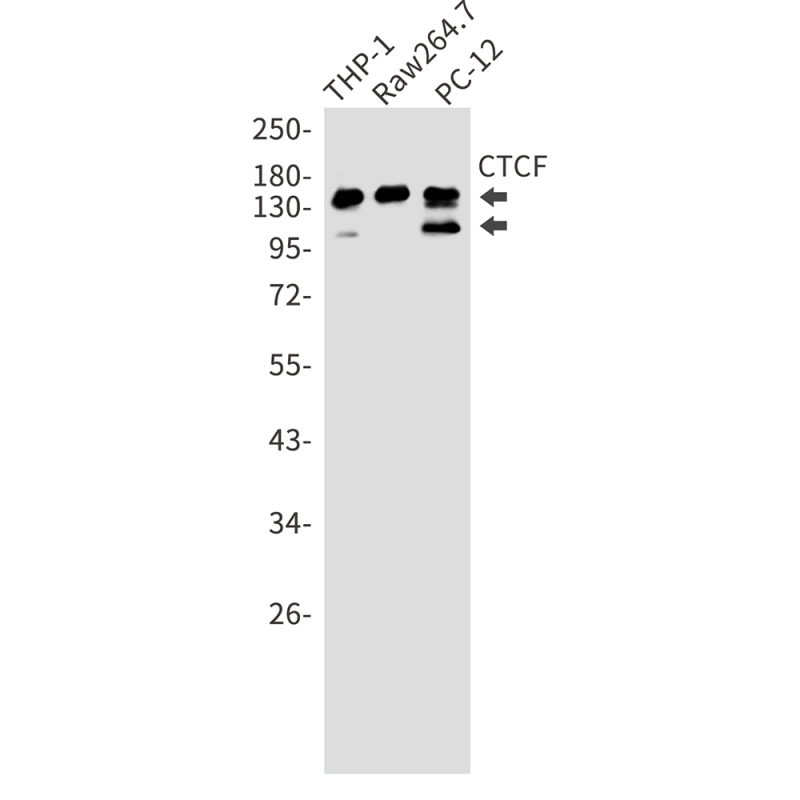
| WB | 咨询技术 | Human,Mouse,Rat |
| IF | 咨询技术 | Human,Mouse,Rat |
| IHC | 1/50-1/100 | Human,Mouse,Rat |
| ICC | 1/50-1/200 | Human,Mouse,Rat |
| FCM | 咨询技术 | Human,Mouse,Rat |
| Elisa | 咨询技术 | Human,Mouse,Rat |
| Aliases | CTCF; Transcriptional repressor CTCF; 11-zinc finger protein; CCCTC-binding factor; CTCFL paralog |
| Entrez GeneID | 10664 |
| WB Predicted band size | Calculated MW: 83 kDa; Observed MW: 140 kDa |
| Host/Isotype | Rabbit IgG |
| Antibody Type | Primary antibody |
| Storage | Store at 4°C short term. Aliquot and store at -20°C long term. Avoid freeze/thaw cycles. |
| Species Reactivity | Human,Mouse,Rat |
| Immunogen | A synthetic peptide of human CTCF |
| Formulation | Purified antibody in TBS with 0.05% sodium azide,0.05%BSA and 50% glycerol. |
+ +
以下是3-4篇关于CTCF抗体的代表性文献及其摘要概括,供参考:
---
1. **文献名称**: *CTCF: Master Weaver of the Genome*
**作者**: Phillips JE, Corces VG
**摘要**: 该综述总结了CTCF蛋白在基因组三维结构调控中的作用,重点讨论了其通过形成染色质环(chromatin loops)调控基因表达的功能。文中提到使用特异性CTCF抗体(如Millipore 07-729)进行ChIP-seq实验,验证了CTCF在染色质边界(insulator)和拓扑关联域(TAD)中的定位。
---
2. **文献名称**: *Loss of CTCF-associated chromatin domains in cancer*
**作者**: Flavahan WA et al.
**摘要**: 本研究通过CTCF抗体(Abcam ab70303)结合ChIP-seq技术,分析了癌症中CTCF结合位点的异常缺失。发现CTCF结构域的破坏与致癌基因激活相关,揭示了CTCF在维持基因组稳定性和抑癌功能中的关键作用。
---
3. **文献名称**: *Comparative analysis of CTCF antibody performance in chromatin immunoprecipitation*
**作者**: Zheng H et al.
**摘要**: 该研究系统比较了多种商业CTCF抗体(包括Millipore、Active Motif、Cell Signaling Technology产品)在ChIP实验中的灵敏度和特异性,提出了抗体选择和数据解释的优化方案,为表观遗传学研究提供方法学参考。
---
4. **文献名称**: *CTCF mediates chromatin looping in neural development*
**作者**: Hirayama T et al.
**摘要**: 利用CTCF抗体(Diagenode C15410010)在小鼠模型中研究神经发育过程,发现CTCF通过动态调控染色质互作网络影响神经元分化,揭示了其在大脑发育中的表观遗传调控机制。
---
**备注**:以上文献为示例性质,具体引用时请核实来源及实验细节(如抗体货号可能随版本更新而变化)。建议通过PubMed或期刊数据库搜索最新研究。
CTCF (CCCTC-binding factor) is a highly conserved zinc finger protein that plays a pivotal role in chromatin organization, transcriptional regulation, and epigenetic maintenance. As a multifunctional nuclear protein, CTCF acts as a transcriptional activator, repressor, or insulator protein, depending on its genomic context. It is best known for mediating chromatin looping through its ability to form long-range interactions, thereby shaping 3D genome architecture and regulating enhancer-promoter communication. CTCF also establishes boundary elements to segregate chromatin domains, influences X chromosome inactivation, and participates in genomic imprinting.
Antibodies targeting CTCF are essential tools in studying these mechanisms. They are widely used in techniques like chromatin immunoprecipitation (ChIP-seq) to map genome-wide CTCF binding sites, as well as in immunofluorescence and Western blotting to assess its expression and localization. Given CTCF's involvement in diseases such as cancer—where its dysregulation impacts oncogene expression or genome stability—CTCF antibodies are critical for exploring disease mechanisms. However, researchers must validate antibody specificity due to potential cross-reactivity with similar zinc finger proteins or CTCF isoforms. Proper validation using knockout controls ensures reliable interpretation of experimental data, advancing research in epigenetics, developmental biology, and disease modeling.
×